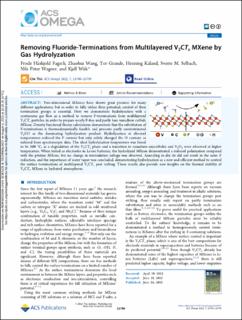| dc.contributor.author | Fagerli, Frode Håskjold | |
| dc.contributor.author | Wang, Zhaohui | |
| dc.contributor.author | Grande, Tor | |
| dc.contributor.author | Kaland, Henning | |
| dc.contributor.author | Selbach, Sverre Magnus | |
| dc.contributor.author | Wagner, Nils Peter | |
| dc.contributor.author | Wiik, Kjell | |
| dc.date.accessioned | 2022-09-27T07:04:42Z | |
| dc.date.available | 2022-09-27T07:04:42Z | |
| dc.date.created | 2022-06-24T13:59:58Z | |
| dc.date.issued | 2022 | |
| dc.identifier.citation | ACS Omega. 2022, 7 (27), 23790-23799. | en_US |
| dc.identifier.issn | 2470-1343 | |
| dc.identifier.uri | https://hdl.handle.net/11250/3021591 | |
| dc.description.abstract | Two-dimensional MXenes have shown great promise for many different applications, but in order to fully utilize their potential, control of their termination groups is essential. Here we demonstrate hydrolyzation with a continuous gas flow as a method to remove F-terminations from multilayered V2CTx particles, in order to prepare nearly F-free and partly bare vanadium carbide MXene. Density functional theory calculations demonstrate that the substitution of F-terminations is thermodynamically feasible and presents partly nonterminated V2CO as the dominating hydrolyzation product. Hydrolyzation at elevated temperatures reduced the F content but only subtly changed the O content, as inferred from spectroscopic data. The ideal hydrolyzation temperature was found to be 300 °C, as a degradation of the V2CTx phase and a transition to vanadium oxycarbides and V2O3 were observed at higher temperature. When tested as electrodes in Li-ion batteries, the hydrolyzed MXene demonstrated a reduced polarization compared with the pristine MXene, but no change in intercalation voltage was observed. Annealing in dry Ar did not result in the same F reduction, and the importance of water vapor was concluded, demonstrating hydrolyzation as a new and efficient method to control the surface terminations of multilayered V2CTx post etching. These results also provide new insights on the thermal stability of V2CTx MXene in hydrated atmospheres. | en_US |
| dc.language.iso | eng | en_US |
| dc.publisher | American Chemical Society (ACS) | en_US |
| dc.rights | Navngivelse 4.0 Internasjonal | * |
| dc.rights.uri | http://creativecommons.org/licenses/by/4.0/deed.no | * |
| dc.subject | ,X-ray photoelectron spectroscopy | en_US |
| dc.subject | Two dimensional materials | en_US |
| dc.subject | Granular materials | en_US |
| dc.subject | Etching | en_US |
| dc.subject | Annealing (metallurgy) | en_US |
| dc.title | Removing fluoride-terminations from multilayered V2CTx MXene by gas hydrolyzation | en_US |
| dc.title.alternative | Removing fluoride-terminations from multilayered V2CTx MXene by gas hydrolyzation | en_US |
| dc.type | Peer reviewed | en_US |
| dc.type | Journal article | en_US |
| dc.description.version | publishedVersion | en_US |
| dc.rights.holder | © 2022 The Authors. Published by American Chemical Society | en_US |
| dc.source.pagenumber | 23790-23799 | en_US |
| dc.source.volume | 7 | en_US |
| dc.source.journal | ACS Omega | en_US |
| dc.source.issue | 27 | en_US |
| dc.identifier.doi | 10.1021/acsomega.2c02441 | |
| dc.identifier.cristin | 2034867 | |
| dc.relation.project | Norges forskningsråd: 275810 | en_US |
| cristin.ispublished | true | |
| cristin.fulltext | original | |
| cristin.qualitycode | 1 | |

